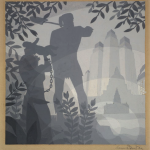Overflowing with historical reference and a captivating story, Aaron Douglas’s The Founding of Chicago tells the tale of Jean Baptist Pointe du Sable, a Haitian fur trader believed to be the founder of the city of Chicago [2]. Created in 1933, a time when African Americans were fighting for basic civil rights, Douglas constructed a more promising image. In this ensemble of gouache on paper, Douglas tells the story of progression, hope, and hard work.
This work represents a restructuring of perspective on American culture. Americans look to the hard work of their founding fathers and base their cultural identity on the foundation of such greatness. Douglas recreates the idea of America for Black culture. In this image, he imagines African Americans as crucial to the construction of the United States.
Using an array of greys, Douglas displays the idea of a tomorrow [1]. Notice the objects that appear closer are a darker grey on the left side then the picture gradually gets lighter toward the right side. That shift of light exemplifies the progression from rural areas and hardships to more urban areas and opportunities. The buildings seem to stretch upward to give a visual representation of the expansion of Chicago. Again, the artist uses light to reference progression by making the colors of the building transcend from darkness to light.
Taking notice of the silhouette figures, who appear to gaze out from the darkened wilderness onto the bright modern city of Chicago—collapsing space and time in order to bridge the gap between Black history and the progress of America.
The silhouette of a woman in bondage raising her child is powerful. Even while chained, she raises her child with the hopes of a better future. The woman may represent Du Sable’s mother, an enslaved African woman, holding up her son, who would go on to be a free man [3]. Jean Baptist Pointe du Sable was born between 1745-1750 in the village of St. Marc, Haiti. Born to a slave mother and a French mariner, Du Sable was taken to France to gain an education. He had acquired an interest in art and language. Using his skills, he began sailing ships for his father, and on one horrific trip to present-day New Orleans, the boat was damaged and he was injured. He eventually made it to the mainland, but unfortunately all items of identification were lost. Being an unknown free black man in America, he faced arrest or enslavement.
Under the protection of French Jesuits, he recovered and decided to venture north, following the Mississippi River. His final destination was at the mouth of the Chicago River. The Pottawatomie Indians dominated the area, but using his language skills, he soon befriended them and established himself as the first settler of Chicago. Taking full advantage of the location, Du Sable constructed buildings and initiated a fur and meat trading business in 1768. After the Revolutionary War, his business gained recognition throughout the region. In 1800, Du Sable left Chicago and sold his property. He died in August 1818, coincidentally; the same year Illinois became a state.
Fascinated with the rich history of blacks and their efforts to improve the unfortunate circumstances, Aaron Douglas’s work symbolizes their struggle and how they are viewed culturally. Born in Topeka, Kansas, Douglas was one of the most sought after African American artist during the Harlem Renaissance Era [1]. The son of a laborer and a homemaker, the contrast of hard work and struggle was all too familiar.
Douglas used his artistic talents and quality education to escape the harsh living conditions of the Jim Crow south. Southern culture often serves as a foundation in his artwork. When he moved North during the Harlem Renaissance, his art became the standard for artist using artistic language to display a compelling social message.
There is a contrast between the role of men and women in this picture that Americans can identify with. The subject in this picture is Jean Baptist Pointe du Sable, a man who is believed to have founded Chicago. The male subject represents the strength and hard work of men. This picture suggests the traditional outlook on the privilege and freedom of men. He is holding a shovel which suggest that he plans to do some work. Through the eyes of a male, this picture may symbolize the freedom of man and the idea of power. Another approach is to look at it through the eyes of a woman. The woman can allude to the natural nurturing instinct in females and the lack of rights and freedom women were deprived of and still fight for today. The woman reflects nurturing side of woman and the hope to achieve more.
Capturing the significant role blacks played in American history, Aaron Douglas tells the story behind the founding of Chicago. By using different shades of grey and silhouette figures, he celebrates the progression of African Americans and American culture. He redefines how blacks view history and the influential figures known for founding American institutions. Douglas is known as “The Father of Black American Art”[4] for depicting the harsh reality of black America while relaying a social message.
JALS
Sources
1. Kirschke, Amy Helene. Women Artists of the Harlem Renaissance. Oxford: n.p., 2014. Pg.192-193. Print.
2. “The Founding of Chicago” by Aaron Douglas Acquired by Spencer Museum of Art. Spencer Museum of Art, 25 July 2006. Web. 16 July 2015.
3. “Spencer Acquires Douglas Depiction.” KU Connections. KU Alumni Association, n.d. Web. 16 July 2015.
4. Kansapedia: Kansas Historical Society. N.p., Nov. 2012. Web. 15 July 2015.
